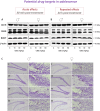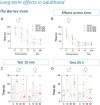Adolescent cannabidiol treatment produces antidepressant-like effects without compromising long-term cognition in rats
- PMID: 40522606
- PMCID: PMC12241299
- DOI: 10.1007/s43440-025-00750-5
Adolescent cannabidiol treatment produces antidepressant-like effects without compromising long-term cognition in rats
Abstract
Background: Recent preclinical studies have shown sex-dependent antidepressant-like responses of cannabidiol in adolescence, which were dependent on biological sex, early-life stress, and dose. In particular, cannabidiol (10 mg/kg) induced acute and sustained antidepressant-like responses in adolescent male rats, while it lacked efficacy in females. This follow-up study aimed at further characterizing cannabidiol's effects in adolescence, in an attempt to overcome female unresponsiveness, while also evaluating its long-term safety profile in adulthood.
Methods: Groups of adolescent rats of both sexes were treated (ip) with cannabidiol (10, 30, 60 mg/kg) or vehicle (1 ml/kg) for 7 days. Acute (30 min post-injection) and repeated (24 h post-treatment) antidepressant-like responses were measured in the forced-swim test. Brains were collected to evaluate several neurochemical correlates in the hippocampus (CBR1, CBR2, BDNF, and cell proliferation) after adolescent cannabidiol exposure (acute and repeated). Some rats were left undisturbed until adulthood, when long-term effects on cognition were measured in the Barnes maze (short- and long-term memory) or affective-like responses in the forced-swim test. Data was analyzed with two-way ANOVAs (independent variables: sex and treatment).
Results: While the dose of 10 mg/kg of cannabidiol induced antidepressant-like effects in adolescent rats, higher doses had no effect in adolescent rats of both sexes. No changes were observed in any of the hippocampal neuroplasticity markers evaluated. Adolescent cannabidiol exposure did not induce long-term changes in cognitive performance or affective-like behavior.
Conclusions: Overall, our data suggest that adolescent cannabidiol treatment produces dose-dependent antidepressant-like effects of moderate magnitude without compromising long-term cognition in rats.
Keywords: Adolescence; Antidepressant; Biological sex; Cannabidiol; Hippocampus; Neuroplasticity.
© 2025. The Author(s).
Conflict of interest statement
Declarations. Competing interests: The authors declare no competing interests.
Figures




References
-
- Ledesma-Corvi S, Jornet-Plaza J, Gálvez-Melero L, García-Fuster MJ. Novel rapid treatment options for adolescent depression. Pharmacol Res. 2024;201:107085. - PubMed
-
- Bis-Humbert C, García-Cabrerizo R, García-Fuster MJ. Decreased sensitivity in adolescent versus adult rats to the antidepressant-like effects of Cannabidiol. Psychopharmacology. 2020;237:1621–31. - PubMed
-
- Bis-Humbert C, García-Cabrerizo R, García-Fuster MJ. Antidepressant-like effects of Cannabidiol in a rat model of early-life stress with or without adolescent cocaine exposure. Pharmacol Rep. 2021;73:1195–202. - PubMed
MeSH terms
Substances
LinkOut - more resources
Full Text Sources
Medical
Miscellaneous
